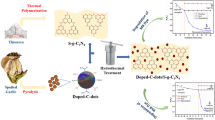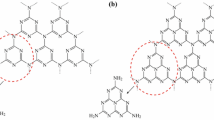Abstract
A novel and efficient photocatalyst g-C3N4/Sb was constructed by impregnating graphitic carbon nitride with 2D antimonene in this study. XRD, SEM, FT-IR and XPS results all confirmed the successful construction of g-C3N4/Sb heterojunction. Inhibited recombination of photogenerated electron–hole pairs and enhanced photocatalytic activity are observed for the composited sample. Under light irradiation, the composite shows a three-fold increased degradation rate for methylene blue. The reaction efficiency retains about 92.4% after three test cycles, suggesting great stability of the catalyst. Meanwhile, photoelectrochemical test results show that the overpotential for oxygen evolution reaction is lowered to 322 mV and the photocurrent response is elevated by six times for g-C3N4/Sb compared to pristine g-C3N4. It is concluded that the junction between 2D antimonene and g-C3N4 provides a channel for the high-speed transfer of photogenerated carriers, which helps to improve photocatalytic performance. This work provides a new way to construct the two-dimensional heterojunction based on g-C3N4 for improved catalytic performance.






Similar content being viewed by others
References
Ding Y, Ma X, Zhang X (2023) Flame-assisted hydrolysis synthesis as a green combustion alternative for the preparation of metal oxide photocatalysts: Reactions and opportunities. J Alloys Comp 959:170540. https://doi.org/10.1016/j.jallcom.2023.170540
Ma X, Wang Z, Cui X et al (2019) Surface photovoltage spectroscopy observes sub-BandGap defects in hydrothermally synthesized SrTiO3 nanocrystals. J Phys Chem C 123:25081–25090. https://doi.org/10.1021/acs.jpcc.9b06727
Ou M, Wan S, Zhong Q et al (2018) Hierarchical Z-scheme photocatalyst of g-C3N4@Ag/BiVO4 (040) with enhanced visible-light-induced photocatalytic oxidation performance. J Appl Catal B: Environ 221:97–107. https://doi.org/10.1016/j.apcatb.2017.09.005G
Ma X (2022) Graphynes for photocatalytic and photoelectrochemical applications. Prog Chem 34:1042–1060. https://doi.org/10.7536/pc210636
Wang X, Maeda K, Thomas A et al (2009) A metal-free polymeric photocatalyst for hydrogen production from water under visible light. J Nat Mater 8:76–80. https://doi.org/10.1038/nmat2317
Li Y, Zhou M, Chen B et al (2020) Recent advances in g-C3N4-based heterojunction photocatalysts. J Mater Sci Tech 56:1–17. https://doi.org/10.1016/j.jmst.2020.04.028
Wang Y, Tan G, Dang M et al (2022) Study on surface modification of g-C3N4 photocatalyst. J Alloys Comp 908:164507. https://doi.org/10.1016/j.jallcom.2022.164507
Niu Y, Hu F, Xu H et al (2023) Exploration for high performance g-C3N4 photocatalyst from different precursors. Mater Today Comm 34:105040. https://doi.org/10.1016/j.mtcomm.2022.105040
Zhou Q, Peng F, Ni Y et al (2016) Long afterglow phosphor driven round-the-clock g-C3N4 photocatalyst. J Photochem Photobio A: Chem 328:182–188. https://doi.org/10.1016/j.jphotochem.2016.06.002
Fan C, Feng Q, Xu G et al (2018) Enhanced photocatalytic performances of ultrafine g-C3N4 nanosheets obtained by gaseous stripping with wet nitrogen. Appl Surface Sci 427:730–738. https://doi.org/10.1016/j.apsusc.2017.08.090
Wang T, Zheng J, Cai J et al (2022) Visible-light-driven photocatalytic degradation of dye and antibiotics by activated biochar composited with K doped g-C3N4: Effects, mechanisms, actual wastewater treatment and disinfection. Sci Total Environ 839:155955. https://doi.org/10.1016/j.scitotenv.2022.155955
Li Y, Jin R, Xing Y et al (2016) Macroscopic foam-like holey ultrathin g-C3N4 nanosheets for drastic improvement of visible-light photocatalytic activity. Adv Energy Mater 6:1601273. https://doi.org/10.1002/aenm.201601273
Si H, Deng Q, Yin C et al (2020) Gas exfoliation of graphitic carbon nitride to improve the photocatalytic hydrogen evolution of metal-free 2D/2D g-C3N4/graphdiyne heterojunction. J Alloy Compd 833:155054. https://doi.org/10.1016/j.jallcom.2020.155054
Zhao G, Hao S, Guo J et al (2021) Design of p-n homojunctions in metal-free carbon nitride photocatalyst for overall water splitting. Chin J Catal 42:501–509. https://doi.org/10.1016/S1872-2067(20)63670-1
Liu Q, Ai L, Jiang J (2018) MXene-derived TiO2@C/g-C3N4 heterojunctions for highly efficient nitrogen photofixation. J Mater Chem A 6:4102–4110. https://doi.org/10.1039/C7TA09350K
Song X, Hu Y, Zheng M et al (2016) Solvent-free in situ synthesis of g-C3N4/{001}TiO2 composite with enhanced UV- and visible-light photocatalytic activity for NO oxidation. Appl Catal B 182:587–597. https://doi.org/10.1016/j.apcatb.2015.10.007
Sun Z, Wang H, Wu Z et al (2018) g-C3N4 based composite photocatalysts for photocatalytic CO2 reduction. Catal Today 300:160–172. https://doi.org/10.1016/j.cattod.2017.05.033
Humayun M, Ullah H, Shu L et al (2021) Plasmon assisted highly efficient visible light catalytic CO2 reduction over the noble metal decorated Sr-incorporated g-C3N4. Nano-Micro Lett 13:209. https://doi.org/10.1007/s40820-021-00736-x
Sun C, Liu Y, Wang Z et al (2021) Self-assembled g-C3N4 nanotubes/graphdiyne composite with enhanced photocatalytic CO2 reduction. J Alloys Compd 868:159045. https://doi.org/10.1016/j.jallcom.2021.159045
Han Q, Wang B, Gao J et al (2016) Atomically Thin mesoporous nanomesh of graphitic C3N4 for high-efficiency photocatalytic hydrogen evolution. ACS Nano 10(2):2745–2751. https://doi.org/10.1021/acsnano.5b07831
Zhang G, Lan ZA, Lin L et al (2016) Overall water splitting by Pt/g-C3N4 photocatalysts without using sacrificial agents. Chem Sci 7(5):3062–3066. https://doi.org/10.1039/C5SC04572J
Yang S, Gong Y, Zhang J et al (2013) Exfoliated graphitic carbon nitride nanosheets as efficient catalysts for hydrogen evolution under visible light. Adv Mater 25(17):2452–2456. https://doi.org/10.1002/adma.201204453
Zhu B, Zhang J, Jiang C et al (2017) First principle investigation of halogen-doped monolayer g-C3N4 photocatalyst. Appl Catal B: Environ 207:27–34. https://doi.org/10.1016/j.apcatb.2017.02.020
Lin Y, Wang L, Yu Y et al (2021) Construction of molecularly doped and cyano defects co-modified graphitic carbon nitride for the efficient photocatalytic degradation of tetracycline hydrochloride. New J Chem 45(39):18598–18608. https://doi.org/10.1039/D1NJ03602E
Guo S, Tang Y, Xie Y et al (2017) P-doped tubular g-C3N4 with surface carbon defects: Universal synthesis and enhanced visible-light photocatalytic hydrogen production. Appl Catal B: Environ 218:664–671. https://doi.org/10.1016/j.apcatb.2017.07.022
Xia X, Xie C, Xu B et al (2022) Role of B-doping in g-C3N4 nanosheets for enhanced photocatalytic NO removal and H2 generation. J Ind Eng Chem 105:303–312. https://doi.org/10.1016/j.jiec.2021.09.033
Shang Q, Fang Y, Yin X et al (2021) Structure modulation of g-C3N4 in TiO2{001}/gC3N4 hetero-structures for boosting photocatalytic hydrogen evolution. RSC Adv 11:37089. https://doi.org/10.1039/D1RA07691D
You Z, Wu C, Shen Q et al (2018) A novel efficient g-C3N4@BiOI p–n heterojunction photocatalyst constructed through the assembly of g-C3N4 nanoparticles. Dalton Trans 47:7353–7361. https://doi.org/10.1039/C8DT01322E
Wang X, He J, Zhou B et al (2018) Bandgap-tunable preparation of smooth and large two-dimensional antimonene. Angew Chem Int Ed 57:8668–8673. https://doi.org/10.1002/anie.201804886
Wang H, Yuan H, Hong S et al (2015) Physical and chemical tuning of two-dimensional transition metal dichalcogenides. Chem Soc Rev 9:2664–2680. https://doi.org/10.1039/C4CS00287C
Ares P, Palacios JJ, Abellan G et al (2018) Recent progress on antimonene: A new bidimensional material. Adv Mater 30:1703771. https://doi.org/10.1002/adma.201703771
Gao J, Zhang S, Ma X et al (2023) Two-dimensional Sb modified TiO2 nanorod arrays as photoanodes for efficient solar water splitting. Nanomater 13:1293. https://doi.org/10.3390/nano13071293
Xu X, Zhang F, Wang M et al (2018) Excellent nonlinear absorption properties of β-antimonene nanosheets. J Mater Chem C 6:2848–2853. https://doi.org/10.1039/C8TC00306H
Zhang S, Zhou W, Ma Y et al (2017) Antimonene oxides: Emerging tunable direct bandgap semiconductor and novel topological insulator. Nano Lett 17:3434–3440. https://doi.org/10.1021/acs.nanolett.7b00297
Barrio J, Gibaja C, García-Tecedor M et al (2020) Electrophoretic deposition of antimonene for photoelectrochemical applications. Appl Mater Today 20:100714. https://doi.org/10.1016/j.apmt.2020.100714
He N, Cao S, Gu J et al (2022) Well-designed oxidized Sb/g-C3N4 2D/2D nanosheets heterojunction with enhanced visible-light photocatalytic disinfection activity. J Colloid Interface Sci 606:1284–1298. https://doi.org/10.1016/j.jcis.2021.08.122
Ma D, Zhao J, Wang R et al (2019) Ultrathin GeSe nanosheets: From systematic synthesis to studies of carrier dynamics and applications for a high-performance UV–vis photodetector. ACS Appl Mater Inter 11:4278–4287. https://doi.org/10.1021/acsami.8b19836
Zhang F, He J, Xiang Y et al (2018) Semimetal–semiconductor transitions for monolayer antimonene nanosheets and their application in perovskite solar cells. Adv Mater 30:1803244. https://doi.org/10.1002/adma.201803244
Cui Y, Ding Z, Liu P et al (2012) Metal-free activation of H2O2 by g-C3N4 under visible light irradiation for the degradation of organic pollutants. Phys Chem Phys 14(4):1455–1462. https://doi.org/10.1039/C1CP22820J
Gao W, Zhao Y, Mao Z et al (2018) Enhanced visible light photocatalytic activity for g-C3N4/SnO2: Sb composites induced by Sb doping. J Mater Sci 53(13):9473–9485. https://doi.org/10.1007/s10853-018-2259-7
Wang C, Han T, Xin C et al (2021) Synthesizing the high surface area g-C3N4 for greatly enhanced hydrogen production. Catalysts 11(7):832. https://doi.org/10.3390/catal11070832
Papailias I, Todorova N, Giannakopoulou T et al (2020) Novel torus shaped g-C3N4 photocatalysts. Appl Catal B: Environ 268:118733. https://doi.org/10.1016/j.apcatb.2020.118733
Yang X, Qian F, Zou G et al (2016) Facile fabrication of acidified g-C3N4/g-C3N4 hybrids with enhanced photocatalysis performance under visible light irradiation. Appl Catal B: Environ 193:22–35. https://doi.org/10.1016/j.apcatb.2016.03.060
Jagadhesan S, Senthilkumar N, Senthilnathan V et al (2018) Sb doped ZnO nanostructures prepared via co-precipitation approach for the enhancement of MB dye degradation. Mater Res Express 5(2):025040. https://doi.org/10.1088/2053-1591/aaaf80
Meng S, An P, Chen L et al (2021) Integrating Ru-modulated CoP nanosheets binary co-catalyst with 2D g-C3N4 nanosheets for enhanced photocatalytic hydrogen evolution activity. J Collold Interface Sci 585:108–117. https://doi.org/10.1016/j.jcis.2020.11.066
Kang S, He M, Chen M et al (2019) Polymeric structure optimization of g-C3N4 by using confined argon-assisted highly-ionized ammonia plasma for improved photocatalytic activity. J Collold Interface Sci 556:214–223. https://doi.org/10.1016/j.jcis.2019.08.040
Zhang J, Fu J, Dai K (2022) Graphitic carbon nitride/antimonene van der Waals heterostructure with enhanced photocatalytic CO2 reduction activity. J Mater Sci Tech 116:192–198. https://doi.org/10.1016/j.jmst.2021.10.045
Lente G (2018) Facts and alternative facts in chemical kinetics: remarks about the kinetic use of activities, termolecular processes, and linearization techniques. Curr Opin Chem Eng 21:76–83. https://doi.org/10.1016/j.coche.2018.03.007
Sahin M, Gubbuk IH (2022) Green synthesis of palladium nanoparticles and investigation of their catalytic activity for methylene blue, methyl orange and rhodamine B degradation by sodium borohydride. Reac Kinet Mech Cat 135:999–1010. https://doi.org/10.1007/s11144-022-02185-y
Mai X, Lin W, Chen JN et al (2022) Synthesis of Z-scheme (001)-TiO2/Bi5O7I heterojunctions with enhanced interfacial charge separation and photocatalytic degradation of Rhodamine B. Reac Kinet Mech Cat 135:3447–3459. https://doi.org/10.1007/s11144-022-02309-4
Funding
This work was supported by the National Natural Science Foundation of China (No.52002241), Class III Peak Discipline of Shanghai—Materials Science and Engineering (High-Energy Beam Intelligent Processing and Green Manufacturing), and Shanghai University Teachers’ Production, Study and Practice plan.
Author information
Authors and Affiliations
Corresponding author
Ethics declarations
Conflict of interest
The authors declare that they have no known competing financial interests or personal relationships that could have appeared to influence the work reported in this paper.
Additional information
Publisher's Note
Springer Nature remains neutral with regard to jurisdictional claims in published maps and institutional affiliations.
Supplementary Information
Below is the link to the electronic supplementary material.
Rights and permissions
Springer Nature or its licensor (e.g. a society or other partner) holds exclusive rights to this article under a publishing agreement with the author(s) or other rightsholder(s); author self-archiving of the accepted manuscript version of this article is solely governed by the terms of such publishing agreement and applicable law.
About this article
Cite this article
Gao, J., Liao, X., Ma, X. et al. Facile fabrication of 2D-2D g-C3N4/Sb heterojunction with enhanced photocatalytic degradation activity of methylene blue. Reac Kinet Mech Cat 137, 453–466 (2024). https://doi.org/10.1007/s11144-023-02535-4
Received:
Accepted:
Published:
Issue Date:
DOI: https://doi.org/10.1007/s11144-023-02535-4




